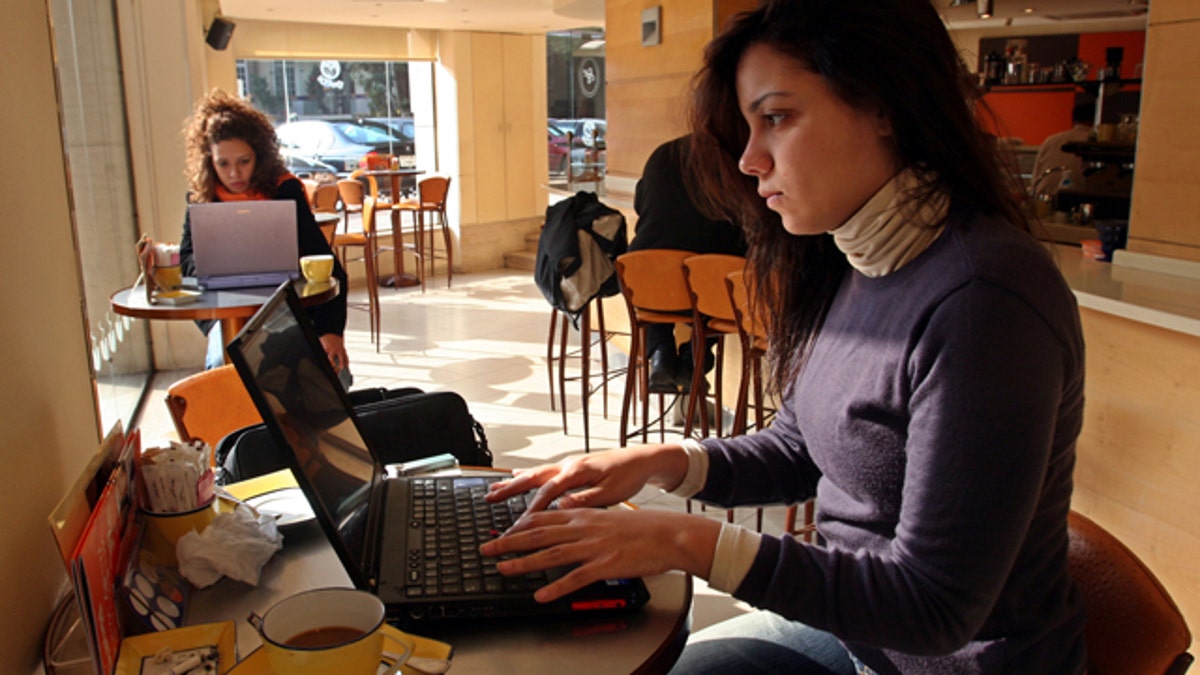
FILE: Egyptians work on their computers in a cafe in Cairo. (Reuters)
Scientists have told us for years that Wi-Fi is safe. But concerned parents can be tough nuts to crack.
Despite years of research and public education, some parents in Canada are blaming their children's illnesses on the wireless Internet routers installed in their schools, and they're calling for the setups to be removed.
"Six months ago, parents started noticing their kids had chronic headaches, dizziness, insomnia, rashes and other neurological and cardiac symptoms when their kids came home from school," said Rodney Palmer, who has two children, 5 and 9 years old, in the Simcoe County school district in Ontario.
He told the Toronto Sun that symptoms started to appear last year when the school board installed wireless networking hardware throughout its schools. Palmer said concerned parents found the microwave signals in classrooms to be four times stronger than signals at the base of a cellphone tower -- though that amount was 600 times less than what the government considers a harmful limit.
And that explains why scientists worldwide continue to roll their eyes.
"As far as I'm aware, there is no evidence that any kind of radio frequency radiation (including cellphone towers, cellphones themselves,and also including Wi-Fi) cause any negative health effects," said Michael First, a professor of clinical psychiatry at Columbia University in New York City and editor of the DSM-IV, the diagnostic bible for psychiatrists.
Noting that concerns about electromagnetic radiation have centered on brain tumors, he said, "I believe that all of the studies done to look into this are negative."
The World Health Organization agrees, noting that the range of radiation exposure from Wi-Fi routers is between 0.002 percent and 2 percent of recommended maximum levels -- less than people receive from televisions and FM radios. (Oddly, cordless home phones, which use the same 2.4-GHz frequency, have avoided the same kind of public scrutiny.)
Schools have increasingly installed Wi-Fi networks to aid learning and boost Internet use in classrooms. But worries over microwave radiation continue to fuel a debate over the safety of regular exposure, especially in children.
Susan Clarke, a former research consultant to the Harvard School of Public Health who studies radio-frequency's bioeffects and was invited to speak to the parents in Simcoe County last week, is not as sure as her colleagues that the radiation is harmless.
"A child’s brain absorbs this radiation maximally," she told the parents, according to reports. "Children also absorb microwave radiation more readily than adults because they have thinner skulls."
Clarke reportedly told the parents she believes that such exposure can cause a slew of neurological and cardiac symptoms, including the ones Palmer described.
The Harvard School of Public Health could not confirm Palmer's findings, nor would it comment on similar findings. And the overwhelming majority of scientists say that evidence of Wi-Fi’s harmful effects remains anecdotal at best, and is often disproved.
Numerous studies over the years have supported the safety of low-level radiation from devices like cellphones -- a recent 30-year study in Sweden could not confirm that they were a hazard -- and Wi-Fi routers are even further removed from the body, lessening their impact.
Researchers have shown that those who claim to be "sensitive" to electromagnetic radiation have difficulty determining its presence. One study found that symptoms correlated with those who had been informed of radiation, whether or not radiation sources were actually active -- hinting that it could be psychological.
Robert Bradley, director of consumer and clinical radiation protection at Health Canada, noted that "if you look at the body of science, we're confident that there is no demonstrable health effect or effects from wireless technology."
The British Health Protection Authority has stated that Wi-Fi equipment emits only a fraction of the signal of common cellphones. "When we conducted measurements in schools, typical exposures from Wi-Fi are around 20 millionths of the international guideline levels of exposure to radiation. As a comparison, a child on a mobile phone receives up to 50 percent of guideline levels."
But despite mountains of strong evidence proving otherwise, questions about the safety of regular exposure to electromagnetic fields won’t go away.
Last year, British DJ Steve Miller gained notoriety for his claims of Wi-Fi allergies, saying he got severe headaches and dizziness whenever he came close to a wireless signal. Miller later admitted his claims were a publicity stunt.
Public concerns have even pushed Sweden to recognize the ailment as an official disability. But American scientists will take no such action, First said. The official bible of illness, the DSM-IV, is being updated to the DSM-V, but Wi-Fi allergies won't make the cut, he told FoxNews.com.
"Changes are made based on solid scientific evidence. Certainly there is no good scientific evidence supporting the notion of electromagmetic-radiation-induced cognitive dysfunction," First said.
Some schools are nonetheless ignoring the scientists and preemptively banning new network installations.
Lakehead University in Thunder Bay, Ontario, outlawed Wi-Fi throughout its campus in 2006, when school president Fred Gilbert likened Wi-Fi radiation to second-hand smoke and asbestos.
"We’re just finding out now what some of those impacts are," he said at the time. A school policy banning wireless networking remains in place today.
John Dance, superintendent of education for the Simcoe County District School board, is taking a more measured approach. Acknowledging the benefits of wireless networking, he said he was wary of taking drastic action. "Nobody’s ever given medical documentation to say that somebody is sick because of this," he said. As of now, the board has denied requests to shut down the network.
But for Rodney Palmer, waiting isn’t an option. Tired of exposing his children to what he describes as an "experiment," the worried father says he is looking into finding alternative schools.




















